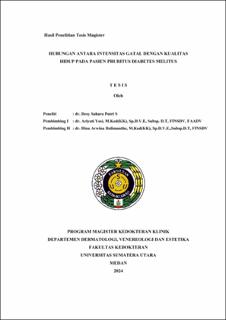Hubungan Antara Intensitas Gatal dengan Kualitas Hidup pada Pasien Pruritus Diabetes Melitus
The Relationship Between Itching Intensity and Quality of Life in Pruritus DM Patients

Date
2024Author
S, Desy Sahara Putri
Advisor(s)
Yosi, Ariyati
Dalimunthe, Dina Arwina
Metadata
Show full item recordAbstract
Background: Pruritus can be caused by various dermatological diseases ranging
from autoimmune, genetic, and infectious to various systemic diseases such as
endocrine and metabolic. Pruritus is a non-infectious skin manifestation that often
occurs in patients with diabetes mellitus (DM). Skin complaints such as pruritus
can significantly affect the quality of life in DM patients and evaluated using the
Dermatology Life Quality Index (DLQI) questionnaire.
Aim: To determine the relationship between itching intensity and quality of life in
pruritic DM patients.
Subjects and Methods: This study was an observational study with a crosssectional
design of 76 DM patients with pruritus. All study subjects underwent
anamnesis, physical examination, dermatological examination, filling out the
DLQI questionnaire, and pruritus severity assessment with the Numerical Rating
Scale. The relationship between itching intensity and quality of life was analyzed
using the Chi Square test and was significant if the p-value <0.05.
Results: DM pruritus is most common in women (60.5%) with group 55-65 years
(48.7%), duration of the disease 6.8 years, oral antidiabetic treatment (46.1%),
randomized blood glucose 242.78 mg/dL, and HbA1c 10.280%. Pruritus DM
subjects mostly were found to have moderate itching (57.9%). The quality of life
of pruritus DM patients based on the DLQI is mostly moderately influential on the
quality of life of patients (73.6%). The results of this study showed that there was
no relationship between itching intensity and quality of life of pruritus DM
patients (p=0.157).
Conclusion: There was no relationship between itching intensity and quality of
life in pruritus DM patients.
